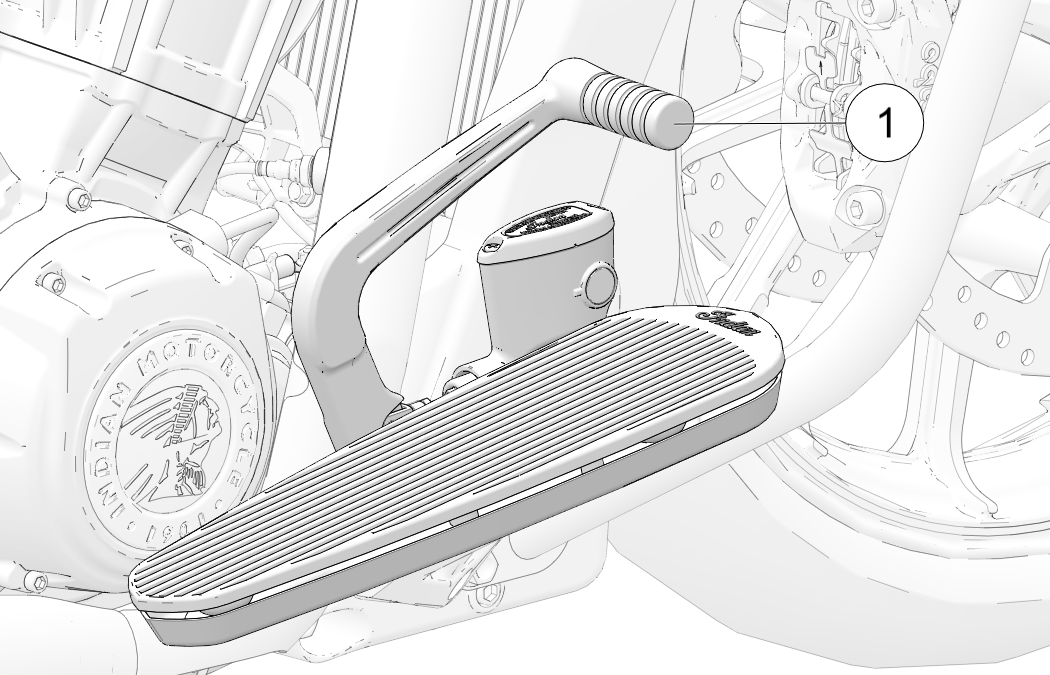Content Source:
2020 Indian Challenger Rider’s Manual (9931163 R02) > Instruments,
Features and Controls Chapter
| IMPORTANT |
|
The Owner's Manual for this vehicle contains
warnings, instructions and other information you must read and fully
understand
before safely riding or performing maintenance
on this vehicle.Always follow the warnings and instructions in Owner's
Manual.
Click the CONTENTS link above for the Table Of
Contents, or download a full PDF of the Owner Manual in the Owner
Support area
of Polaris.com
|
Brakes
The front brake lever
activates the front brake calipers. The rear brake pedal activates
the rear brake caliper. For maximum
brake effectiveness, apply the front brake lever and
the rear brake pedal together.
Anti-Lock Brake System
(ABS)
The anti-lock brake
system automatically adjusts brake pressure as needed to provide optimum
braking control, reducing the
chance of wheel lock-up during hard braking events
or when braking on rough, uneven, slippery or loose surfaces. See
Anti-Lock
Brake System Response.
- The anti-lock brake
system cannot be turned off.
- The ABS indicator
always illuminates when vehicle power is turned on. It remains illuminated
until the anti-lock system activates,
which occurs when vehicle speed exceeds
6 MPH (10 km/h).
- When the lamp is
illuminated, the anti-lock brakes will not activate, but the conventional
brake system will continue to operate
normally.
- When the anti-lock
brakes engage during a braking event, the rider will feel pulsing
at the brake levers. Continue
to apply steady pressure to the brakes for the best stopping performance.
- If the ABS light
does not come on when the key is turned to the ON or PARK position,
your authorized INDIAN MOTORCYLE dealer
can assist.
- If the lamp continues
to illuminate after vehicle speed exceeds 6 MPH (10 km/h), the ABS
system is not functioning. See your
INDIAN MOTORCYCLE dealer or other dealer
promptly for service.
- Operating with non-recommended
tires or improper tire pressure may reduce the effectiveness of the
anti-lock brake system.
Always use the recommended size and type
of tires specified for your vehicle. Always maintain the recommended
tire pressure.
- The anti-lock brake
system will not prevent wheel lockup, loss of traction or loss of
control under all conditions. Always adhere to all safe motorcycle-riding practices as recommended.
- It is not unusual
to leave tire marks on the road surface during a hard braking event.
- The anti-lock brake
system does not compensate for or reduce the risks associated with:
- excessive speed
- reduced traction
on rough, uneven or loose surfaces
- poor judgment
- improper operation
Front Brake Lever
The front brake
lever is located on the right handlebar. This lever controls only
the front brakes. The front brakes should
be applied simultaneously with the rear brakes.
To apply the front brake, pull the lever toward the handlebar. See
Braking for braking procedures. Front brake lever reach (distance to the
hand grip) is adjustable.
- Gently push and hold the lever away from the hand
grip. The adjuster wheel
 is located on top of the lever.
is located on top of the lever.
- To increase reach
distance, rotate the adjuster to a lower number.
- To decrease the reach
distance, rotate the adjuster to a higher number.
Rear Brake Pedal
The rear brake
pedal

is located on the right side of the motorcycle.
Press downward on the rear brake pedal to apply the rear brake.

 WARNING WARNING |
| Resting your foot on the brake pedal will cause excessive and premature
wear of brake pads and reduced braking efficiency,
which could result in severe
injury or death. |
See
Braking for braking procedures.


